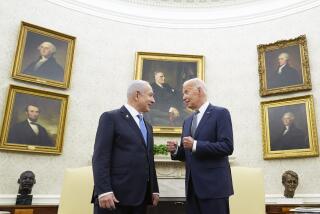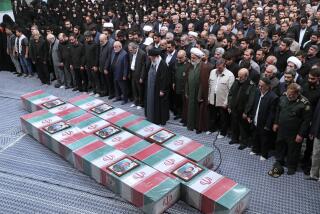Terrorist Risk to Americans in Croatia Is Linked to Iran
WASHINGTON — Last year, as Iran was shipping weapons to Bosnia and Croatia with American acquiescence, U.S. officials in the Croatian capital of Zagreb suddenly became aware of a harrowing threat: Iranian-sponsored terrorists were stalking them in apparent preparation for an attack.
Hezbollah militants from Lebanon, trained and funded by Iran, had arrived in the Croatian capital and were watching American embassy personnel and their families, U.S. officials said. Some carried video cameras and taped the Americans as they came and went.
Central Intelligence Agency and State Department officials tightened the embassy’s security, fearing that an attack was imminent. “The terrorist threat went right up the scale to the levels you would see in preparation for an attack,” said one official.
The suspected terrorists, officials said later, were members of the Iranian-backed organization responsible for the 1983 bombings of the U.S. Marine barracks and U.S. Embassy in Beirut.
No terrorist attack was launched, however. Other events intervened. Rebel Serb forces shelled Zagreb with artillery in May 1995, prompting the evacuation of American dependents and nonessential embassy personnel. As a result, the available targets for terrorists were fewer in number and better protected.
Nevertheless, the terrorists and their apparent plots were seen by some U.S. and Croatian officials as harbingers of a more threatening Iranian presence in the Balkan state--a presence that grew significantly once Croatia, with the United States’ knowledge, began collaborating with Tehran to ship weapons to the Bosnian Muslims.
Since the disclosure of the secret U.S. policy shift to allow arms to flow to the Bosnian Muslims, in spite of a United Nations arms embargo, debate has focused on the wisdom of giving the Iranian regime greater influence in Bosnia.
However, senior U.S. officials familiar with the situation in Croatia said that the implications in that country are just as troubling.
“The terrorist threat faced by American personnel grew exponentially in the months following the green light,” said one senior U.S. official. The problems continue as the U.S. tries now to uproot an Iranian presence seen as a danger to the U.S. peacekeepers in the region and to the effort to contain the spread of terrorism.
Iranian Influence
Clinton administration officials acknowledged that the Iranian influence increased in Croatia after the smuggling operation began but emphasized that the United States took steps to counter the threat of terrorism.
“We take very seriously the question of protecting Americans and U.S. officials overseas, and we would have been very strong in carrying out that mission,” a senior official said. “A regular part of our dialogue with the Croatians has been the presence of terrorist groups,” the official added.
“To the extent that there may have been a heightened presence of terrorists targeting U.S. interests or U.S. people, we would have worked very diligently to bring those matters to the attention of Croatian authorities. There is no doubt about our view about the Iranian presence in Croatia and Bosnia--we disapprove of it strongly and do so publicly and privately.”
The officials said they realized at the time that the arms smuggling had negative side effects but that the Muslims forces--much less well-armed than their Serbian foes--needed the arms to survive, and the Iranians were the ready suppliers.
The increase in Iran’s influence in Bosnia and Croatia is only one of the complications the administration has encountered since secretly signing off on the pipeline for Iranian arms in the spring of 1994.
Another has been making sure that the U.S. role in the smuggling did not become an active one, which would risk a direct violation of the U.N. arms embargo and U.S. law on covert actions.
In at least one case, The Times has learned, the United States found itself coming close to the line, with American officials actually inspecting in September 1995, a shipment of battlefield missiles that were en route to Bosnia to ensure that they were not equipped with chemical weapons.
U.S. officials found no signs of chemical warheads and allowed the shipment to proceed. This involvement, however, suggested something more than merely looking the other way in relation to arms smuggling, as President Clinton’s decision had directed.
Go-Ahead From U.S.
Clinton, concerned about the suffering of the Muslims, secretly gave the green light for a major Iranian weapons pipeline into Bosnia in April 1994, after Croatian President Franjo Tudjman posed the idea and asked through diplomatic channels what the U.S. response would be.
During the Bush administration, the United States had vigorously protested such smuggling.
But Tudjman and other leading officials were hopeful of a change and eager for a cut of any shipments flowing across their border. Others in the Croatian government, though, were concerned about such a relationship with Iran and fearful that it might lead to expanded ties. In fact, the final go-ahead came over the objections of Croatia’s foreign minister, U.S. sources said.
According to sources, Croatian Foreign Minister Mate Granic urged U.S. officials to say no to Tudjman. Miroslav Tudjman, Franjo Tudjman’s son and the chief of Croatia’s intelligence apparatus, also opposed the Iranian initiative, U.S. officials said. With his government split, Tudjman almost certainly would not have allowed the Iranian shipments to begin without U.S. approval, some U.S. officials said.
U.S. intelligence officials said that Hezbollah terrorist cells were operating in Zagreb before the pipeline. But, they noted, the agents’ numbers and operations significantly increased in the fall of 1994, after the Iranian cargo aircraft began to land regularly in Croatia.
Although officials could not prove any direct link, at least some of the Lebanese Hezbollah agents showed up in Zagreb about the same time as Iranian officials who arrived to staff a larger Iranian embassy and nurture Iran’s growing military and diplomatic ties with Croatia.
Some U.S. officials close to the situation in Zagreb said that the administration initially was slow to recognize the extent of the problem. The United States demanded only that the Croatians deal with the terrorist threat against U.S. personnel, rather than protest its larger relationship with the Iranian regime.
Senior administration officials insisted, however, that their response was appropriate. The fact that U.S. and Iranian interests seemed to coincide on the arms operation did not seem to deter the terrorist threat, though. “You can’t expect logical thinking from terrorists,” said one senior official.
Once the Iranian shipments were underway, the Clinton administration found itself embroiled in another way: its interest in what was included in the shipments.
Missile Inspection
Administration officials have emphasized that U.S. involvement in the Iranian pipeline was entirely passive. The administration merely told Croatia that it would not object to Tehran’s shipments moving through Croatia.
But in September 1995, experts from the Army and CIA secretly inspected a covert shipment of Iranian missiles bound for Bosnia after receiving a warning that the weapons were tipped with deadly chemical warheads, administration officials disclosed.
Croatian Defense Minister Gojko Susak seized the short-range ground-to-ground missiles and told U.S. officials that they might contain chemical warheads. Susak apparently feared that the missiles represented a sharp and troubling escalation in the firepower that the Iranians were providing the Bosnian Muslims through the U.S.-sanctioned pipeline.
Alarmed, the Americans immediately called in both the Army and the CIA. But the experts determined that the warheads did not contain chemical or biological agents and allowed them to pass through to Bosnia, U.S. officials said.
Some U.S. officials believe that the decision to inspect the Iranian missiles and then permit them to be delivered represents direct U.S. involvement in arms shipments in violation of the U.N. arms embargo that the United States had pledged to uphold.
The timing of the inspection--just two months before the United States convened peace talks in Dayton, Ohio, to end the civil war--also suggests that the administration was allowing Iranian arms to flow until it demanded at Dayton that all Iranian-backed Islamic foreign forces be withdrawn from Bosnia.
While refusing to confirm the missile inspection, one senior administration official said that such an action “would not constitute any kind of a deepening of involvement at all. It would not have been anything too greatly out of the ordinary, because it’s not at all unheard of for us to follow up on a lead like that and check it out so we know what’s involved. It simply falls under the category of informing ourselves, cluing ourselves in. It would fall under the category of regular intelligence activity.”
Sources said that some Croatian government officials have alleged privately that senior administration officials, including Peter Galbraith, the U.S. ambassador to Croatia, pressured them to allow the missiles to be transshipped to Bosnia after the U.S. had determined that they contained conventional warheads. Galbraith has strongly denied the allegations, including when he testified at a closed hearing of the Senate Intelligence Committee, which is investigating the Clinton arms policy. Senior State Department officials said that they believe Galbraith.
Clinton’s policy on the arms pipeline was the subject of a secret, six-month investigation by the Intelligence Oversight Board, a small White House agency charged with investigating wrongdoing in the U.S. intelligence community.
In its May 1995 report, the board criticized the administration for the excessive secrecy surrounding the policy. But it determined that the administration had not broken any U.S. laws and that the policy could be defined as “traditional diplomatic activity” that did not require congressional notification or a formal presidential finding required for covert action. The board concluded that the United States had not played a direct role in the Iranian arms pipeline.
The U.S. inspection of the Iranian missiles occurred months after the Intelligence Oversight Board concluded its investigation and was not covered by its report on the policy, according to Tony Harrington, chairman of the board. Harrington said in an interview that he did not know about the missile inspection.
More to Read
Sign up for Essential California
The most important California stories and recommendations in your inbox every morning.
You may occasionally receive promotional content from the Los Angeles Times.











